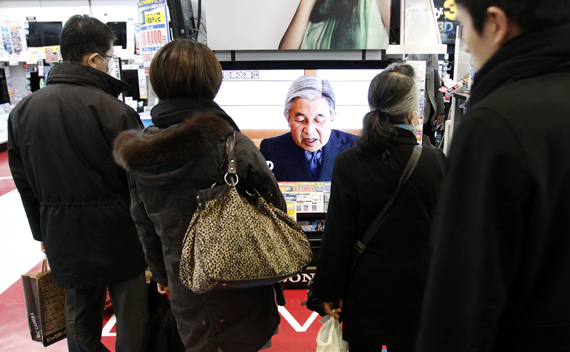Emperor Urges Japanese to Hope as Acute Needs Grow
More on:

[Click here for information on how to locate friends and family in Japan, and here for how you can help]
Day five of the struggle to cope with the devastation in Japan brings increasing fears, but it has revealed yet again the herculean effort currently underway across Japanese society to address the complex and urgent needs of the nation.
Japan’s Emperor Akihito, in a recorded message, asked the Japanese people not to give up hope and to reach out to each other in this time of great crisis. He urged the earliest relief be delivered to those in northeast Tohoku region who are still suffering after the earthquake and tsunami, and asked those at the damaged Fukushima Daiichi plant to do all that they could to avoid a worsening of the situation.
As NHK continued its reporting on the fire damage at the Fukushima Daiichi plant, new information came in from the Public Safety Commission that the radiation levels had dropped. For the first time all day it seemed possible to try again to get water to the reactors. The minute-by-minute coverage continued, and a letter delivered to NHK by children of a worker at the plant was read aloud. The letter asked the country to understand that their father was prepared to fight until the end, and urged authorities to find a way bring him and others at the plant food and water. This brings home the human cost that attends the heroic effort of those first responders on site who are working to bring the reactors under control.
But the frustrations elsewhere are growing. Supplies are not getting to the half million or more in Tohoku. In Tokyo and beyond, trucks are being loaded with food and water. Ten hours on the road to the closest supply areas are only the beginning of the journey. Roads into the coastal towns and evacuation sites remain blocked. The biggest challenge for those in these areas is gasoline. Even if roads are open, people have no means of getting anywhere. Many are walking the newly bulldozed roads to try to find their missing families.
According to NHK, nine refineries are located in this Tohoku region alone, but six of them are closed. Production of 4.5 million liters has dwindled to 3.1 million liters. Supply depots for bringing oil and gasoline to the north are similarly damaged. Japan’s oil companies are moving gasoline by ship to Niigata and Akita on the Sea of Japan coast, but roads east are similarly difficult to pass. With the electricity out in the affected areas, gasoline stands are also unable to get up and running.
But some signs of movement are evident. The Tohoku expressway, originally reserved for rescue and relief forces, is now open for supply efforts, and supply trucks are beginning to move north in increasing numbers. Some of the ports in Miyagi and Iwate have been cleared of debris, and will offer new ways in for supply efforts. As of the end of the day, roads to the badly hit towns of Hizentakada, Hisaichi and Kassenuma are reportedly almost open.
Once supplies reach communities in the north, the challenge will be to distribute to those not only in evacuation centers but to those without power, heat or information still living in their own homes. Convenience stores and supermarkets that remain are empty. Food producers have prepared meals, but are waiting to get permission to fly them in. Lawson, one of Japan’s biggest convenience store, has 40,000 ready-made meals to send. Air transport will be the key to getting these basic needs met quickly.
Today, 4,340 Japanese are confirmed dead, and 9,083 are still missing. But the focus of national energy at the moment is concentrated on those who have survived.
The crisis caused by Japan’s three disasters—earthquake, tsunami and nuclear—continues, and the nation’s basic needs remain acute—and growing.
More on:
 Online Store
Online Store